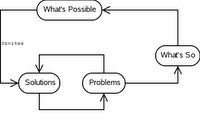I just finished a training course on generative thinking. Before I go any further, I must say that I feel I did learn skills, techniques, and information of value in this course. So if you ever are asked to take such a course, I'd say to do it; just be aware of what it is. To be clear - there is some value here.
I also have to say this is probably (and intended to be) the first of a series of blogs about this. It's too much information for one blog, and I have to get this written down in order to calm down about it.
Okay. Now, to talk about Generative Thinking Part 1, or How To Get Paid To Teach Bunk. Don't take this to mean that the whole thing is bunk. For example, you will find that this is a sort of a Jedi mind trick to help you win arguments.
1. Build a basis that defines itself with circular logic. For example, a basis where, in order to use what you learn, you have to first put it into practice; in order to understand it, you first have to make sense of it, etc. In this case, make a claim that you are going to teach techniques on how to communicate effectively, and then require them to master these skills before they can learn them.
2. Establish a precedent for listening. This is an important piece of foundational information which sets a stage where only you have the right to talk. Express that in the class you will be presenting an idea that they need to just try to accept as a possible reality. This will come in useful later.
3. Invent a vocabulary. Use phrases like "listen for, don't listen about" and "give granted trust, not earned trust" that don't really make any sense. Explain to the class that what this means is that you just decide to listen to and accept another point of view as valid for them. What you really mean is that you are exerting the right to say whatever you want and the class rescinds their right to question not only your information but also your reasoning.
4. Claim that understanding is the "booby prize." I recommend you specifically use these words. This way, whenever someone asks a question such as, "I don't understand what you just said," you can use this so you don't have to repeat yourself. Instead of trying again to teach it, you can simply say, "Well, understanding is the booby prize. You don't need to understand it."
5. Claim that things are the way you perceive them because you say so. By the way, you have to subtly make it clear that this rule only applies to you, not everyone. If you explicitly say so, they might call you on it, in which case you'll have to resort to rule 6. If you are subtle about it, they might not figure it out until the class is over.
6. If things don't go your way, use emotion, shouting, threats, and/or insults to get your way. Most people will respect an instructor as a position of authority without requiring any demonstration of why they should respect you. So you can use these manipulations as a way to guilt them into submission. For example, if someone asks a question that you don't want to answer, you can say something like, "I can't figure out what is wrong with you people, why you always have to understand everything." Or, if the question they ask exposes a flaw in your teaching, you can become angry, shout at them in front of the whole class, and claim (at a high volume) how disappointed you are that, after all this time, they still insist on being argumentative instead of just listening to what you have to say. You might think this is a bit hypocritical, but move on to #7.
7. You don't have to obey your own rules. You can pick and choose when you want to obey them. For example, you can tell the class that while two people are conversing, everyone else has to listen; but you can interrupt if you want to. You can explain to people that they should take emotion out of their confrontations, but then you can become angry, rude, and condescending (see #6). You can insist that people listen to you, and yet when they talk, you don't have to actually listen to their point of view; instead, you can claim that they are not listening to you.
8. Master key phrases. Some of them are, "You are putting words in my mouth." "That is your opinion, not a fact." "You aren't listening, you insist on arguing with me." Here is an example of how to use them:
Student: "I have a concern about what you have said. If I were to do that, I would get fired."
You: "That is your opinion, not a fact."
Student: "Well, no, it is a fact, because my boss told me, 'If you do that, you are fired.'"
You: "You aren't listening, you insist on arguing with me."
Student: "I feel like you aren't listening to me. You said that I should do (x), and all I did was express a concern about my job."
You: "You are putting words into my mouth."
Student: "No I'm not, I'm trying to understand what you said."
You: "Understanding is the booby prize. This is not about understanding."
Student: "Well, I don't know how I can use something if I don't understand it."
(This is the point at which you start shouting.)
You (shouting): "I have never, in all my years of teaching this course, known anyone so belligerent and insistent on arguing with me as you. You absolutely refuse to learn what I am trying to teach you. Maybe you'd be happier if I just declared this my first ever failure in trying to teach. This is something that you could obviously use, but you simply refuse to learn it."
If you follow all of these steps, more or less in order, you will arrive at nirvana, as long as you define nirvana as: A state where you are always right simply because you assert that you are right, and nobody can challenge you because they rescinded their right, and if they try to, you will beat them into submission.
Can you see how powerful this is? This is a technique wherein you don't have to answer questions that are hard, you can become offended and shout and insult people if they question you, and you don't have to actually succeed in making them learn anything. Powerful! You could create a consulting firm, teaching this stuff to corporations for large sums of money, and nobody could ever prove you wrong - at least, not without getting into a shouting match. Well, you are too late for that, because people are already doing it. But, it could be a great technique for winning arguments.














